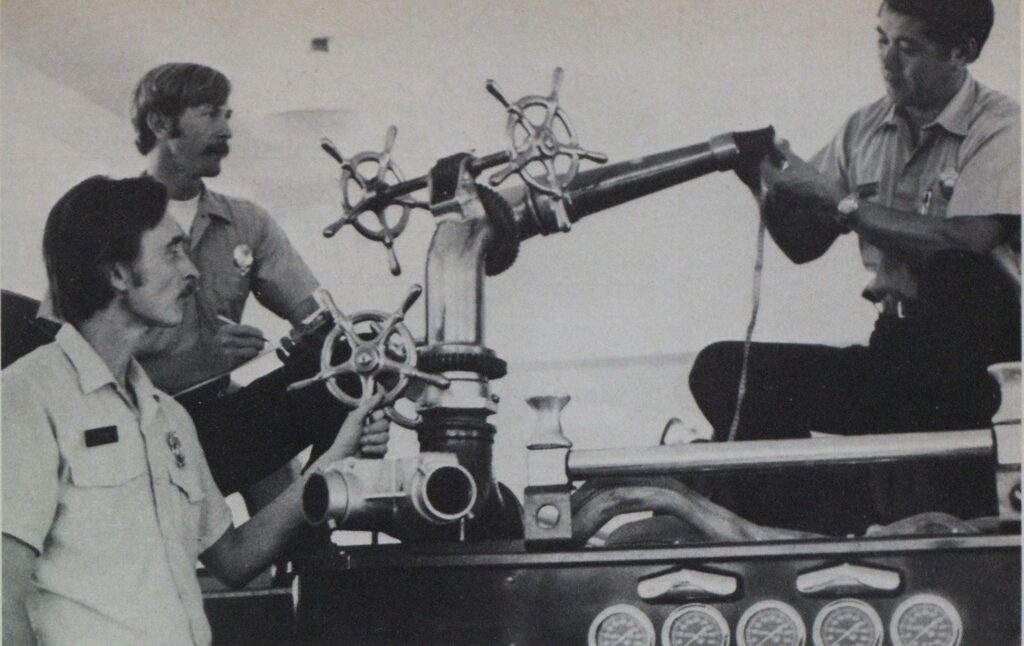
Learn Metric System by Using It
features

Photos by L. Omans
The best way to become familiar with the metric system is to use it, and providing an opportunity to take metric measurements of familiar equipment is the way members of the San Jose, Calif., Fire Department received their introduction to the metric system.
We followed the advice of the California Metric Committee in its “Guidelines for Metric Education” to “think metric” and recognize the fact that “learning to think metric is best accomplished through active experience with instruments and materials.”
The committee pointed out, “It is not at all necessary to convert from the United States customary system to the metric system.”
For those who look for comparisons in learning the metric system, a meter is a little more than a yard, a liter is slightly more than a quart, a kilogram is a bit heavier than two pound and 20 degrees Celsius is a comfortable room temperature.

The pilot course in metric familiarization in the San Jose Fire Department consisted of 2½ hours per shift for seven shifts. At the request of the writer of this article, Battalion Chief Lee Devine exempted the shift from normally scheduled house drills for a month. Thus, the men got their metric indoctrination in an atmosphere of regular training. The format was that of a typical house drill, with one or two men taking the initiative to lead the others through the material.
Movie sets the stage
A movie by General Motors Corporation, borrowed from a nearby manufacturer, was used to get the attention of the troops. This movie is an animated illustration of the complexity of the customary system units compared to metric units. There was never any other motivation needed to keep up the interest level.
A set of 20 transparencies was made to use with a script obtained from a San Jose schoolteacher. The following shift the companies spent approximately 1 ½ hours at the fire department training facility viewing the overhead presentation. At no time were metric units compared to customary units by giving the conversion factors. This practice tends to confuse rather than enhance the education process.
The remaining hours were spent getting hands-on experience with a short review just before the drill for that day. Using some forms that were handed to them, the men measured and weighed various objects, such as hose, ladders, nozzle tips and tools. Almost always, the students were required to estimate the measurement before measuring.
Metric kit used
The men went out in teams of two to accomplish the assigned tasks. Some men found it easier to estimate building heights in meters rather than in feet.
A metric survival kit was purchased to make metric measuring tools available. The kit cost under $12 and included a cubic decimeter, as well as 15 tapes 1.5 meters long and a 5-kg spring scale with a mesh bag to hold objects being weighed.
The 12 remaining hours were actually spent with the men educating each other by experience. The last five hours were dedicated to touching on some hydraulic concepts. The initial fear that the changeover would strip them of their pumping expertise was dispelled by these last two sessions. The basic formulas are the same; only the factors and quantities are different.
A test was given prior to the first class and after the last. The results showed that the students increased their knowledge of the metric system by 64 percent during the hours of instruction. The last test was given 30 days after the final class to measure the information committed to long-term memory.
Seven basic units
The international system of units, the technical name of the metric system and abbreviated as SI, has seven basic units: meter for length, kilogram for mass (weight), second for time, ampere for electric current, kelvin for temperature, mole for amount of substance and candela for luminous intensity.
The fire service will find that the changeover to the metric system will have considerabje impact on hydraulics. The metric system expression for pressure is kilogram per square meter. This is known as one pascal. A multiple of the pascal is the kilopascal (kPa). To find head in kilopascals, use the equation:
p = 10h
when p is pressure in kPa and h is height in meters. In other words, the pressure in kPa is merely 10 times the head in meters.
Flow rates can be expressed in liters per minute or liters per second if smaller figures are desired. In the accompanying tables comparing flows in gpm and Lpm, the flow rate in liters per second can be obtained by dividing the Lpm figure by 60.


